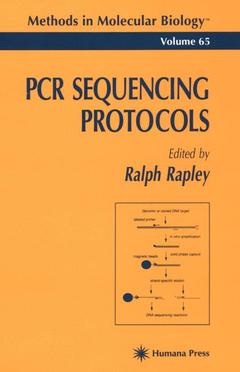PCR Sequencing Protocols, 1996 Methods in Molecular Biology Series, Vol. 65
Langue : Anglais
Coordonnateur : Rapley Ralph

Advances in bioscience research usually arise as a result of the continu ing refinement of existing technologies. However, there are a number of occa sions v^rhere newly developed methodologies have a profound effect on nearly all areas of research. Frequently these are techniques that are elegantly simple in concept and require minimal technical manipulation. Two of these revolu tionary techniques are the focus ofPCR Sequencing Protocols. The first such technique is enzymatic chain termination sequencing developed by Sanger and his co-workers in Cambridge and reported in 1977. This essentially brought the possibility of deriving nucleotide sequence information in a very short time scale and has been widely accepted in many laboratories as a routine molecular biological research tool. Furthermore, it has not only led to the sequencing of many genes and gene fragments, but has also allowed the tech nical means of sequencing the human genome. The second technique that has found widespread acceptance in basic applied research and many routine applications is the polymerase chain reac tion. This technique, first reported in 1985 by MuUis and his colleagues, pro vides the means to amplify nucleic acid sequence, which immediately proved invaluable in nearly all fields of biological laboratory research. Here, as with enzymatic DNA sequencing, is a very simple concept that relies on minimal information to prepare short oligonucleotide primers that direct the synthesis of a specified fi-agment o f DNA in the presence of a thermostable DNA polymerase.
Preparation and Analysis of DNA Sequencing Gels Purification of PCR Products from Agarose Gels for Direct Sequencing Enzymatic Fluorescence and Biotin Labeling of Primers for PCR Sequencing Direct Sequencing of Double-Stranded PCR Products with the Sequencase Kit and [a-35S] dATP Direct Sequencing by Thermal Asymmetric PCR Rapid Sequencing of cDNA Clones: Direct Sequencing Using Sequential Linear/Asymmetric PCR Direct Sequencing of PCR Products Using Chemiluminescent Detection Direct DNA Sequencing of PCR Products Using Magnetic Beads Affinity Capture and Solid-Phase Sequencing Biotinylated PCR Products Analysis of Nucleotide Sequence Variations by Solid-Phase Minisequencing. Nonradioactive PCR Sequencing Using Digoxygenin Silver SequencingTM: Nonradioactive Cycle Sequencing of dsDNA Direct Sequencing of PCR Products with DNA-Binding Proteins PCR Sequencing with the Aid of Detergents Direct Sequencing with Highly Degenerate and Inosine-Containing Primers Determination of Unknown Genomic Sequences Without Cloning DNA Sequencing by the Chemical Method Direct PCR Sequencing with Denaturants (Formamide) Efficient PCR Production of Single-Stranded DNA Sequencing Templates Preparation and Direct Automated Cycle Sequencing of PCR Products Solid-Phase Automated Sequencing of PCR-Amplified Genomic DNA Cloning PCR Products for Sequencing in M13 Vectors Sequencing PCR Products Cloned into M13 Vectors Genome Amplification with Transcript Sequencing (GAWTS) DNA Rescue by Vectorette Method Sequencing (dAidT) of Cloned Mixed PCR Products from Microbial Populations Index
Date de parution : 08-2013
Ouvrage de 221 p.
15.2x22.9 cm
Disponible chez l'éditeur (délai d'approvisionnement : 15 jours).
Prix indicatif 105,49 €
Ajouter au panierThème de PCR Sequencing Protocols :
© 2024 LAVOISIER S.A.S.



